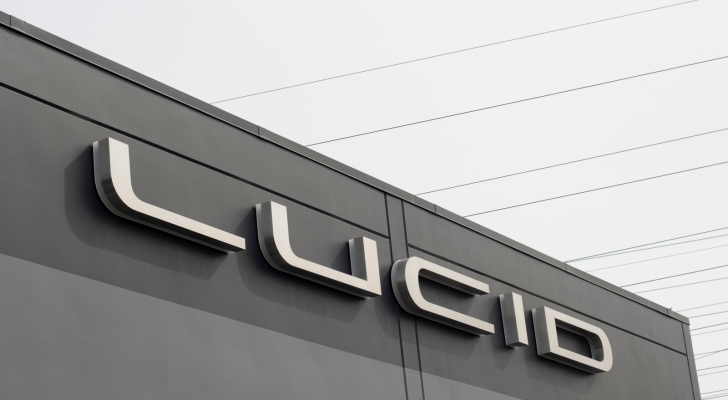4 Meme Stocks to Sell Before They Die
This article is an excerpt from the InvestorPlace Digest newsletter. To get news like this delivered straight to your inbox, click here.
2023 has been an incredible year for the stock market.
The Nasdaq Composite has risen 34% so far, its best showing since 1983.
The macro picture is looking bright, with inflation on the retreat and unemployment remaining low.
Artificial intelligence (AI) is turning seemingly ordinary tech companies into hypergrowth moonshots.
For example, on Thursday, shares of mobile tech firm AppLovin (NASDAQ:APP) surged 22% after management revealed a revenue beat driven by its Axon 2.0 AI system.
InvestorPlace - Stock Market News, Stock Advice & Trading Tips
But some corners of the market have gotten too far ahead. According to FactSet, the average earnings beat in the second quarter saw shares fall by 0.5% on average – a sign of inflated expectations. Tesla (NASDAQ:TSLA), for instance, dropped 10.5% last month after the company reported a 12% earnings beat.
Inflated prices also have found their way into the world of so-called meme stocks – ordinary companies that have gained viral popularity on social media. Shares of Tupperware Brands (NYSE:TUP) have risen 460% in the past month, despite announcing no significant news. And Yellow (NASDAQ:YELL), the recently bankrupt trucking firm, has seen its stock rise 130% since July on meme-stock investor interest.
These skyrocketing valuations make it hard to tell successful startups from pretenders. The sudden rise and fall of Upstart Holdings (NASDAQ:UPST), for example, required a note from Louis Navellier and his team to clarify that the AI-powered lending platform is a legitimate business with support from multiple credit unions. Upstart remains one of his top long-term buys.
Meanwhile, struggling firms can look like tempting investments, at least in the short term. But as writers at our free news and analysis site, InvestorPlace.com, note, a rising tide will lift sinking ships. That’s why, this week, they highlight four meme stocks to sell before they die.
Snap (SNAP)

Source: franviser / Shutterstock.com
Shares of Snapchat parent Snap (NASDAQ:SNAP) surged in February after the social media app announced it was launching My AI, a chatbot designed do everything from recommending birthday gift ideas to writing poems for friends.
The actual product proved to be less refined than expected. Users quickly called the new Snap service “terrifying” and “creepy” as the chatbot began making up answers to questions. My AI even tried teaching young users how to lie to their parents.
Snap’s woes, however, go far beyond rogue AIs. As Terel Miles notes this week at InvestorPlace.com, rising competition and a failing advertising business model are turning this surging stock into a fundamentally broken company.
Snapchat is facing serious challenges in its advertising business, and rising competition from social media apps like TikTok and Instagram. Advertisers are flocking to TikTok to reach their abundant millennial audience and acquire cheaper ad rates per 1000 impressions.
That’s worrying news for Snap, a firm that once traded as high as $80 (it’s now around $10).
Since 2020, average revenues per user (ARPU) have declined by 33% to $2.69. Analysts believe that figure will fall another 10% this year on a weak advertising market. Competition from TikTok and other social media sites could further pressure ARPU figures over the coming years.
So far, Snap has hidden the bad news by adding more daily active users (DAU). In 2022, DAU rose 17% year over year. A rising stock market has also helped shares recover double-digits so far this year.
But these magic tricks won’t work forever. Though shares have levitated so far in 2023, Snap’s fortunes will eventually turn for the worse once the tide of new users begins to ebb.
T2 Biosystems (TTOO)

Source: Near D Krasaesom / Shutterstock.com
At first glance, T2 Biosystems (NASDAQ:TTOO) looks like a perfect investment. The Massachusetts-based diagnostics company is a leader in testing for sepsis, a costly disease that kills 270,000 Americans annually. The firm also has four medical devices in development; two have U.S. Food and Drug Administration Breakthrough Device designations, and shares are up 500% since June.
However, Ian Bezek notes at InvestorPlace.com that a Nasdaq extension for getting back in listing compliance hardly offsets bigger issues.
Unless T2 dramatically boosts revenues or slashes expenses, its balance sheet will be under heavy strain.
T2 has also begun raising cash with convertible instruments, a tactic often known as “death-spiral financing.” Lower share prices can significantly increase the amount of dilution that convertible stock causes, which feeds back into even lower prices and more dilution. It’s why only struggling firms ever consider such terrible fundraising ideas.
Indeed, these effects are already showing on T2’s balance sheet. On Monday, the healthcare firm revealed that its shares outstanding had jumped from 24.9 million last quarter to 333.6 million. Investors own 92.5% less of the company now than they did just three months ago.
More dilution is also on the way. Medical devices cost an average of $54 million to develop, and T2 only has $16 million of cash left. The company’s significant debt burden also prevents T2 from using debt financing as well.
Though T2 shares are on the rise, investors shouldn’t mistake these short-term profits for any long-term gains.
Canoo (GOEV)

Source: T. Schneider / Shutterstock.com
Shares of electric vehicle startup Canoo (NASDAQ:GOEV) surged 35% in July after the California-based firm announced it was expanding its partnership with the U.S. Department of Defense’s Innovation Unit. The firm aims to help standardize modular lithium battery systems for the military. Canoo also delivered three new crew transportation vehicles to NASA the following day.
Behind the good news, however, is a company in deep financial trouble.
Canoo’s latest financial report revealed that its cash position now sits at $6.7 million – a scant figure for a growing EV startup. (For comparison, Tesla consumed $524 million in 2015 to scale up its production.)
This week, Louis Navellier and his team highlighted these growing issues.
Canoo is … in somewhat better shape than Mullen Automotive. But the bar’s not set too high in that comparison. …
Second-quarter earnings will come out later this month, but Canoo will need to improve and beat expectations if it wants to regain any investors’ confidence. It’s better to sit this one out and keep your hands away from GOEV stock. It has an “F” rating in the Portfolio Grader.
Competition is also rising among EV makers. Last month, Ford (NYSE:F) slashed the price of its F-150 Lightning electric pickup truck, reversing a pattern of repeated hikes since 2022. It joins Tesla, Nio (NYSE:NIO), and a host of other firms in price cuts.
Canoo had a window of opportunity to beat incumbents. But the company has squandered that lead with slow development and lackluster presales. Investors beware: Not every rising stock signals a healthy firm.
Lucid Group (LCID)

Source: Tada Images / Shutterstock
The listing of Lucid Group (NASDAQ:LCID) in 2021 was an incredible feat. The “Tesla Killer” had just managed to raise $4.5 billion in the largest special purpose acquisition company (SPAC) merger in history, and its flagship model would soon after get named as the 2022 MotorTrend Car of the Year.
MotorTrend magazine’s “Golden Calipers,” however, have not translated to demand. On Monday, Lucid’s management revealed that the firm only managed to sell 1,404 units in the second quarter, less than two-thirds of its production. The value of its finished inventories has surged ninefold to $445.4 million.
Lucid has since turned to deep price cuts to stimulate demand, a strategy that Louis Navellier and his team warn about this week.
The Lucid brand is still struggling to gain traction. Current efforts to boost demand, like aggressive price cuts for its Air line of luxury EV sedans, will likely at best provide a temporary boost in demand, all while weighing on margins/increasing cash burn.
Unless Lucid suddenly starts to build a Tesla-esque following (even a small one like the following Rivian has developed), pessimism about Lucid’s ability to scale towards profitability will re-emerge.
More cuts will likely be needed to sop up excess inventory. Dealers at established automakers, including General Motors (NYSE:GM) and Ford, now have more than 90 days of unsold EVs at their stores, according to a report from Cox Automotive. Though Lucid’s price cuts now make some models cheaper than a Tesla Model S, few luxury brands have ever managed to discount their way to success.
Who’s Swimming Naked?
In 2001, Warren Buffett quipped, “you only find out who is swimming naked when the tide goes out.” The Sept. 11 attacks had just upended the world of reinsurance, and it turned out that even Buffett companies had made some bad bets. His General RE subsidiary would write off $800 million that year.
It turns out even the Oracle of Omaha can make mistakes in a bull market.
History is repeating itself. Hundreds of popular stocks have risen this summer, backed by a $32 billion tidal wave of net inflows in July. Plenty of low-quality firms are rising along with the high-quality ones.
Many of these companies will fail. The dot-com bubble saw over 800 internet companies collapse, and this current rally will see a similar shakeout. Not all 57,933 AI companies counted by researchers at Exploding Topics, for instance, can possibly survive.
In fact, despite all the spectacular gains in AI stocks this year, Eric Fry is warning that a major AI panic on August 23 is about to change everything.
To help you prepare, Eric is holding an emergency briefing this Wednesday, August 16, at 8 p.m. Eastern.
During the event, Eric will reveal his blueprint for turning this panic into a 1,000% profit potential in the days ahead. Go here to reserve your spot now.
On Penny Stocks and Low-Volume Stocks: With only the rarest exceptions, InvestorPlace does not publish commentary about companies that have a market cap of less than $100 million or trade less than 100,000 shares each day. That’s because these “penny stocks” are frequently the playground for scam artists and market manipulators. If we ever do publish commentary on a low-volume stock that may be affected by our commentary, we demand that InvestorPlace.com’s writers disclose this fact and warn readers of the risks.
Read More: Penny Stocks — How to Profit Without Getting Scammed
As of this writing, Tom Yeung held a LONG position in GM. The opinions expressed in this article are those of the writer, subject to the InvestorPlace.com Publishing Guidelines.
Tom Yeung is a market analyst and portfolio manager of the Omnia Portfolio, the highest-tier subscription at InvestorPlace. He is the former editor of Tom Yeung’s Profit & Protection, a free e-letter about investing to profit in good times and protecting gains during the bad.
More From InvestorPlace
Musk’s “Project Omega” May Be Set to Mint New Millionaires. Here’s How to Get In.
ChatGPT IPO Could Shock the World, Make This Move Before the Announcement
It doesn’t matter if you have $500 or $5 million. Do this now.
The post 4 Meme Stocks to Sell Before They Die appeared first on InvestorPlace.
